FTP Questions
FTP support articles: have any questions about transferring website files to our web hosting, using FTP? Find answers here.
How do I connect to a site with WinSCP?
FTP uploads on our system have a maximum size of 5GB. If you need to upload files larger than this, you'd need to upload these via SSH.
One such tool you can use is WinSCP. With WinSCP, you can connect to your site files via SCP to upload/download, much as you would a standard FTP client.
Firstly, you'll need to create a public/private key-pair as you would when connecting via SSH normally. If you're unfamiliar with this, our SSH guide covers this in more detail. You'll need to connect to your hosting package using this method before continuing, so make sure to set this up and then try connecting via PuTTY to confirm it's up and running before moving on to the next step.
- Log in to My20i, head to Manage Hosting and select the package that you want SSH access for. Then select SSH Access from under the Security section.
- As in the previous guide, input the Public Key that was generated from PuTTYgen into the Public Key box, which will generate a handle for it. Then, select Add Public Key on the page.
- Once done, save the private key locally under any name you want: you'll need this later.
- Open WinSCP. You'll be prompted with a 'Login' form upon loading. You'll want to select 'SCP' under 'File protocol:' at the top.
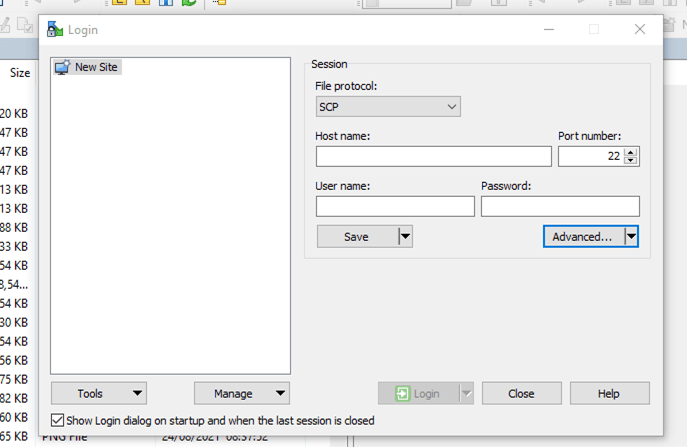
- Then enter the following details:
- Host name: The hostname will depend on what data centre your package is in. For UK packages, this should be ssh.gb.stackcp.com. For packages in the US, please use ssh.us.stackcp.com.
- User name: The domain name of the package
- Port: 22
- Leave the password area of the form blank for now and hit 'Advanced' beneath it. You'll be greeted with an Advanced Site Settings box:

- Navigate to SSH > Authentication and hit the '...' box under 'Private key file'. You can select your Private Key you saved earlier from here.
- Once that's added, hit OK and then Login at the bottom. You'll get a prompt for the password you set with the key pair earlier: enter it here.
- You'll then be fully connected and can use WinSCP to upload/download files as you would a standard FTP client.
 Austin B.
Austin B.How to use SFTP to transfer files securely with a remote server
FTP or “File Transfer Protocol” is a standard protocol for transferring files between two servers. FTP can also be insecure if not properly encrypted. If you’re using one of our Managed VPS or our shared platform then your FTP connection will be encrypted and secure.
SFTP, SSH File Transfer Protocol or Secure File Transfer Protocol is a different protocol that comes with SSH and works in a similar way. Unlike FTP, SFTP is always made over a secure connection. This connection can then be used to transfer files between servers and to traverse the filesystem on both servers.
When connecting to us, as both protocols are secure, you can use your protocol of choice. However, if you’re connecting to a system you’re unfamiliar with, in most cases you’re best off using SFTP for the connection. It’s more secure.
SFTP is part of many UI-based tools, and for those, we recommend referring to a guide for the tool in question. In this guide, we’ll demonstrate the use of SFTP through its command line interface.
Connecting using SFTP?First off, if you’re connecting to a package with us, you’ll first need to make sure that you’ve unlocked the FTP/SFTP on the package in question. It can be unlocked for either a period of time or for the IP address you’ll be connecting from. FTP/SFTP can be unlocked on the right hand side of any package's control panel.
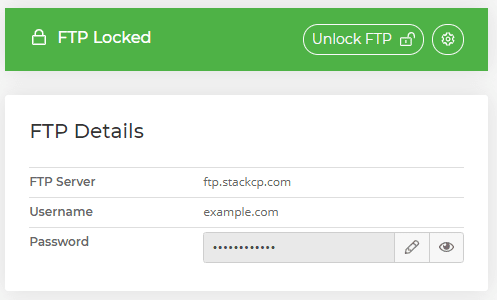
When connecting to us using either FTP or SFTP you’ll need to unlock it here first and then you’ll be able to connect using the given details. If the domain in question has a CNAME set up to point ftp.domain.com to ftp.stackcp.com then you can also connect to our FTP/SFTP using ftp.domain.com. If in doubt ftp.stackcp.com will always work though.
If you’re connecting by SFTP elsewhere you may need to refer to connection guides for the supplier in question. When connecting to a general server the same authentication methods are available that are present in SSH.
When using your own server we would recommend creating SSH keys and transferring your public key to any system that you need to access. This is more secure and can save you time in the long run.
Once the SFTP is unlocked with us or you have set up SSH keys or a different authentication method for your own server, you should now be able to connect to it using the following:
$ sftp username@serverhostname
So using the example from Image1 above that would be:
$ sftp example.com@ftp.stackcp.com
If you are working on a custom SSH port (not the default port 22), then you can open an SFTP session as follows:
$ sftp -oPort=custom_port username@serverhostname
This won’t be necessary if using our shared or Managed Hosting on a VPS.
Once you’re connected to the remote server your prompt will change to an SFTP one.
sftp>
The best command to learn first with SFTP is the help command. This will give you a summary of available SFTP commands. You can get help by typing either:
sftp> help
Or
sftp> ?
This will display a list of commands:
Available commands:
bye Quit sftp
cd path Change remote directory to 'path'
chgrp grp path Change group of file 'path' to 'grp'
chmod mode path Change permissions of file 'path' to 'mode'
chown own path Change owner of file 'path' to 'own'
df [-hi] [path] Display statistics for current directory or
filesystem containing 'path'
exit Quit sftp
get [-P] remote-path [local-path] Download file
help Display this help text
lcd path Change local directory to 'path'
lls [ls-options [path]] Display local directory listing
lmkdir path Create local directory
ln oldpath newpath Symlink remote file
lpwd Display (‘print’) local working directory
ls [-1aflnrSt] [path] Display remote directory listing
lumask umask Set local umask to 'umask'
mkdir path Create remote directory
progress Toggle display of progress meter
put [-P] local-path [remote-path] Upload file
pwd Display (‘print’) remote working directory
quit Quit sftp
rename oldpath newpath Rename remote file
rm path Delete remote file
rmdir path Remove remote directory
symlink oldpath newpath Symlink remote file
version Show SFTP version
!command Execute 'command' in local shell
! Escape to local shell
? Synonym for help
We’ll go through some of the more useful commands and how to use them in the following sections.
Navigating with SFTPWe can navigate around the remote server’s file system using commands similar to normal Linux system commands.
First off we can find out where we are in the file system of the remote server. Just like on a normal Linux server we can use the following to get the current directory:
sftp> pwd
Output:
Remote working directory: /
If you are using SFTP with us the home directory for the user will be displayed as / rather than the actual full path. On other servers you would get the output:
/home/sites/11a/7/74089947f7/
As this is the actual home path but when you are using SFTP with our shared or Managed VPS hosting this will be converted such that the user home path becomes just / and any commands should be done relative to this.
We can also view the contents of the current working directory using the ls command:
sftp> ls
Output:
examplefile1.txt examplefile2.php public_html
The commands within the SFTP interface don’t have as many features as in a normal shell interface but they do have some of the more important optional flags:
sftp> ls -la
Output:
drwx--x--- 4 laravetest.com 48 4096 Sep 20 13:33 . drwx--x--- 4 laravetest.com 48 4096 Sep 20 13:33 .. -rw-rw-r-- 1 laravetest.com laravetest.com 959 Mar 8 2021 .bash_history drwxrwxrwx 3 laravetest.com laravetest.com 4096 Mar 8 2021 .composer -rw-rw-rw- 1 laravetest.com laravetest.com 67 May 14 2020 .htaccess -rw-r--r-- 1 laravetest.com laravetest.com 0 Sep 20 13:32 examplefile1.txt -rw-r--r-- 1 laravetest.com laravetest.com 0 Sep 20 13:33 examplefile2.php drwxrwxr-x 4 laravetest.com laravetest.com 4096 Mar 8 2021 public_html
To move between directories in the file system we can use the cd command.
sftp> cd public_html
We can now move around the remote server’s file system. We also need to be able to access and move around our local system as well though. We can run commands on the local file system by amending l to the front of the commands.
The commands we’re shown above have local file system equivalents so you can get the local working directory as follow:
sftp> lpwd
Output:
Local working directory: /home
You can list the contents of the current working directory on the local machine:
sftp> lls
Output:
config.php index.html local var
We can also move between directories on the local system.
sftp> lcd var
Being able to move between directories and see the files on both the remote and local system is good but you’ll also want to be able to move files between the servers.
Transferring Files from the Remote to the Local ServerIn order to download files from the remote server to our local server we can use the get command:
sftp> get examplefile1.txt
Output:
Fetching /examplefile1.txt to examplefile1.txt
By default, the get command downloads a remote file to a file with the same name on the local file system.
You can also copy the remote file to a different name by specifying the name afterwards if you wish:
sftp> get examplefile1.txt localexample.txt
You can also use some option flags with the get command. For example you can copy a directory and all its contents by specifying the recursive option -r:
sftp> get -r public_html/
We can then also tell SFTP to keep the original permissions and access times for the downloaded files using -p.
sftp> get -rp public_html
Moving files from your local server to the remote server it just as easily done but this time you’ll need to use the put command:
sftp> put examplefile1.txt
Output:
Uploading examplefile1.txt to /examplefile1.txt examplefile1.txt
You can use the same flags with the put command as you can with the get command. To copy a local directory therefore, you can do:
sftp> put -r var
A useful tool to use when uploading and downloading files from a remote server is the df command. This works in a similar manner to the command line version. You can use this to check the amount of available on the remote server:
sftp> df -h
Note: here we’ve used the -h flag to make the output more human readable.
Output:
Size Used Avail (root) %Capacity
8.7TB 8.4TB 275GB 275GB 96%
There is no local version of the df command in SFTP so in order to check the storage you will need to exit out of the SFTP connection to run df locally.
You can do this with the ! command. This will take us back to the local server where we can check the disk usage:
sftp> !
$ df -h
Output:
Filesystem Size Used Avail Use% Mounted on devtmpfs 373M 0 373M 0% /dev tmpfs 404M 0 404M 0% /dev/shm tmpfs 404M 46M 358M 12% /run tmpfs 404M 0 404M 0% /sys/fs/cgroup /dev/vda1 25G 1.7G 24G 7% / tmpfs 81M 0 81M 0% /run/user/0
Any other command will also work as expected on the local server. You can then return to your SFTP session with:
$ exit
You should now see your SFTP prompt again.
Basic File ManipulationSFTP will also allow you to do simple file maintenance.
For example, you can change the owner of a file on the remote server by using:
sftp> chown userID file
When using SFTP the chmod command doesn’t accept usernames like with the command line equivalent but instead uses UIDs. There also isn’t an easy way to know the appropriate UID from the SFTP unfortunately.
Depending on your access permissions on the system you’re using, a workaround could be:
sftp> get /etc/passwd sftp> !less passwd
Output:
root:x:0:0:root:/root:/bin/bash bin:x:1:1:bin:/bin:/sbin/nologin daemon:x:2:2:daemon:/sbin:/sbin/nologin adm:x:3:4:adm:/var/adm:/sbin/nologin lp:x:4:7:lp:/var/spool/lpd:/sbin/nologin sync:x:5:0:sync:/sbin:/bin/sync shutdown:x:6:0:shutdown:/sbin:/sbin/shutdown halt:x:7:0:halt:/sbin:/sbin/halt mail:x:8:12:mail:/var/spool/mail:/sbin/nologin
In the above, instead of using ! on it’s own first we’ve amended it to the beginning of another command. This then runs the given command in the local shell as if we weren’t in the SFTP interface.
This will work for any command available on your local server and we could have used this to run the df command earlier.
The UID we need is in the third column of the output, as displayed by the separating colons.
In a similar fashion we can change the group owner of a file with:
sftp> chgrp groupID remotefilename
Unfortunately again there is no easy way to get a listing of the remote server’s groups. We can work around this using the following:
sftp> get /etc/group sftp> !less group
Output:
root:x:0: bin:x:1: daemon:x:2: sys:x:3: adm:x:4:centos tty:x:5: disk:x:6: lp:x:7: mem:x:8: kmem:x:9: wheel:x:10:admin cdrom:x:11: mail:x:12:
Like before the third column as denoted by the colons holds the UID for the group given in the first column.
Luckily the chmod command works as expected on the remote file system:
sftp> chmod 755 public_html
Output:
Changing mode on /public_html/
There isn’t a command for changing local file permissions but you can set the local umask meaning that any files copied from the remote to the local server will have the correct permissions.
This can be done using the lumask command:
sftp> lumask 022
Local umask: 022
Now any regular files downloaded from the remote server will have 644 permissions. Given that the -p flag is not used.
SFTP allows you to create directories on both local and remote servers using the lmkdir and mkdir respectively. These work as you would expect.
The following only target the remote file system:
sftp> ln sftp> rm sftp> rmdir
These commands have the same behaviour as their equivalent shell versions. If you need to use these commands on the local system then you can return to the local shell with !:
sftp> !
Or you can execute the command from the SFTP interface by amending it with a !:
sftp> !chmod 644 index.php
When you have finished with SFTP you can use exit or bye to close the connection.
sftp> bye
While SFTP is a relatively simple tool, it’s very useful for administering servers and moving files between them.
A working example would be that you can use SFTP to enable particular users to transfer files without SSH access. If you set up additional FTP users in the control panel for the package with us, these can also be used with SFTP to allow multiple user SFTP access to different parts of a hosting package.
If you’re using FTP or SCP for your transfers then SFTP is a good way to have the strengths of both. Whilst SFTP isn’t the best tool for every situation, it is an effective and useful tool.
 Dominic Elford
Dominic ElfordHow do I use Master FTP?
As a 20i Reseller you can use Master FTP to globally unlock your own IP address across all your hosting packages.
This is so that you don’t need to worry about unlocking FTP for each package every time you need to access them.
To use Master FTP:
- Create a StackCP User for yourself. To create a StackCP User please see this guide.
- Locate your StackCP User from the list and select Options > Edit
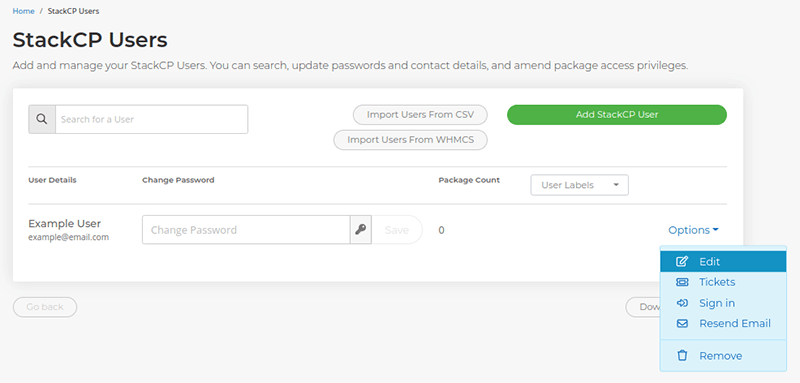
- Select all the Packages you would like to access via Master FTP, then select ‘Save’.

- Select Options > Edit again. This time, scroll to the bottom and you'll see the ‘Master FTP Access’ section. From here, you can select Enable Master FTP and enter your own IP address. This will enable you to gain access to all site files via a single login from this IP.
- Select ‘Add’ once you've entered your IP address

- You should use the following details to connect via your FTP client:
- Host: The value of this depends on which data centre your package is located in.
For packages in the UK: masterftp.gb.stackcp.com
For packages in the US: masterftp.us.stackcp.com
- Username: the StackCP User's email address (e.g. email@example.com)
- Password: the StackCP User's password
You'll now be able access the packages you selected earlier using these details.
 Austin B.
Austin B.How do I upload a large file via FTP?
The maximum FTP upload/download size is 5GB, for anything above you’ll need to use another method to transfer larger file sizes.
The 5GB limit is enough for most use cases and it is not very likely that larger uploads are needed by most users. 5GB is equivalent to 17.5 hours of 720p HD video.
If you need to upload a file that extends the FTP limit you can use tools like Rsync or WinSCP.
We recommend that you enable SSH and then use a client like WinSCP to upload over SSH. There are no limits in this case.
Here is a step-by-step guide on how to connect via SSH using WinSCP on Windows, and here's how to perform an rysnc on Mac and Linux based systems.
 Austin B.
Austin B.How do I migrate a WordPress site automatically?
Migrating a Wordpress website to 20i's scalable platform is quick and easy using our Migration Centre.
To Get Started:
- Log in to My20i
- Click on Migrations in the left navigation panel
- Click Start Migration

4. Choose WordPress from the list and click Next.
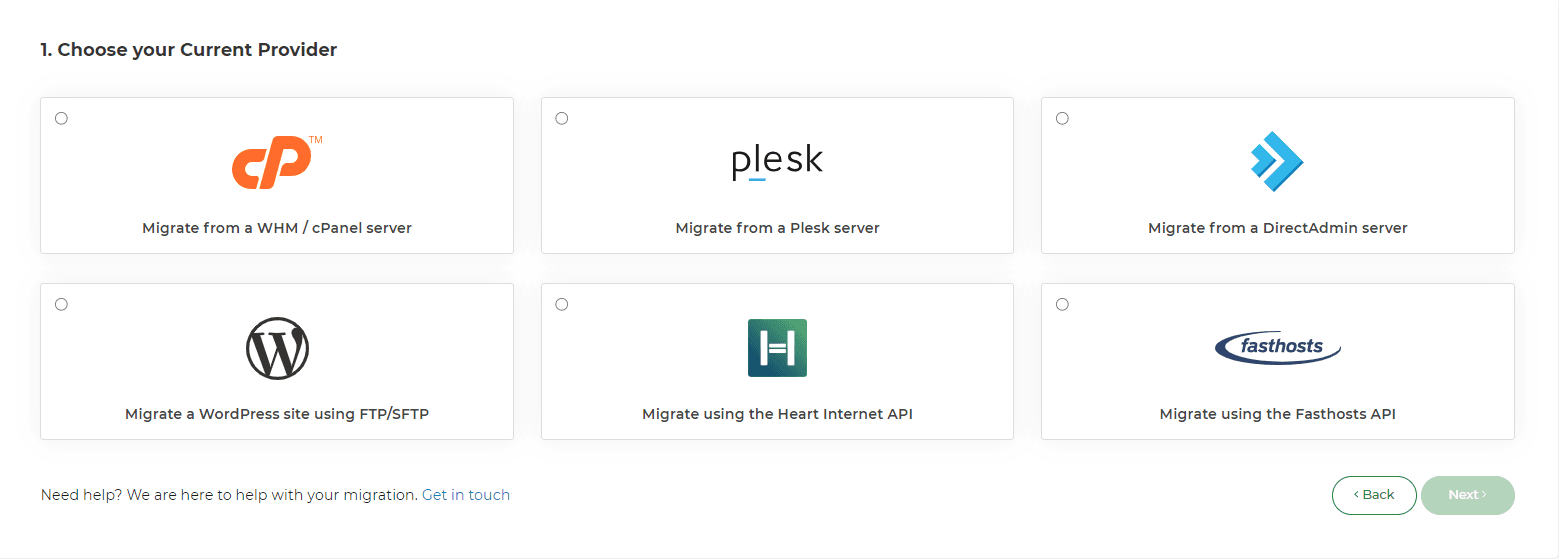
5. Enter the required credentials: hostname, domain, username and password for FTP, and click Next.
6. Go to Migrations Overview in My20i at any time to see the status of your migration. You’ll be notified when it’s successfully completed.

7. Once the migration status has been updated to 'Complete' you can head to Manage Hosting to view the website.
Note: This will only migrate the website to 20i. If you have emails to move as well, you can use our Email Migration tool once the migration has completed.
DNS Records
Note: The Migration Centre does not transfer DNS records.
By default, DNS records will be configured so that they point all services to 20i's services, such as mail and FTP. For example, if you are using Office365 or Gmail you'll want to remove our standard MX records and ensure the Office365/Gmail DNS records have been added before you continue, to avoid any interruption to your mail service.
After migrating your websites, databases, and email, the final step is to update your domain names. You can either transfer your domain name to 20i or leave it with its current registrar and simply point the name servers to your 20i hosting.
If you intend to use our free SSL certificates, the nameservers must be transferred to 20i as a security measure required by the certificate-issuing authority.
Transferring Domain Names
To transfer your own or your customers’ domain names to 20i, head to Transfer a Domain from the Migration Centre section of your 20i control panel. Enter the domain name(s) you want to transfer, confirm them, and then check out.
You can see the progress of your domain transfers from Migration Centre > Pending Domain Transfers. Please note that DNS propagation typically takes an hour but can take anywhere up to 24 hours as a global update is rolled out, so it may be a while before your domain resolves after the nameservers have been updated.
Updating Nameservers
If you’d prefer to update your nameservers with your current domain registrar (meaning you have your non-20i domain pointing to your 20i hosting) instead of transferring your domain to 20i, you will need to log in to your domain registrar’s control panel and update the nameservers to the following:
• ns1.stackdns.com • ns2.stackdns.com • ns3.stackdns.com • ns4.stackdns.com
If your registrar doesn’t support 4 nameservers, simply add as many as it will support. It can take up to 48 hours for nameserver changes to propagate across the web, but in the vast majority of cases, it will be completed much faster.
Congratulations, you’ve successfully migrated to 20i!
Important: You can never have too many backups! Before you delete any data with your old hosting company, please back it up on a separate physical device and/or have a copy in cloud storage. You can also download your data at any time via My20i, or purchase our Timeline Backups service for automatic daily backups.
 Austin B.
Austin B.I can't connect via FTP, what can I do?
There are a few common reasons why you may not be able to connect successfully via FTP.
1. Make sure you're using the correct hostname
If you’ve not switched the nameservers to point to 20i, you’ll need to use a different hostname to connect via FTP:
- For Linux and Windows, you can use: ftp.stackcp.com
- For WordPress you can use: wordpressftp.stackcp.com
2. Make sure you have the FTP DNS record
If you’ve made any DNS changes you need to make sure that you have a CNAME from:
ftp.yourdomain.com -> CNAME -> ftp.stackcp.com (or wordpressftp.stackcp.com on the WordPress platform).
Without this CNAME you won’t be able to connect using ftp.yourdomain.com.
Please note DNS changes can take roughly 1 hour to propagate.
3. Make sure FTP is unlocked
At 20i we utilise an FTP lock system to ensure FTP can only be accessed when required which greatly reduces the risk of compromise to a hosting package. You'll need to make sure this is unlocked to connect via FTP, to do this:
- Login to My20i
- Select the hosting package you want to unlock FTP for from Manage Hosting
- You can then select to unlock FTP by time, or by a specific IP address.
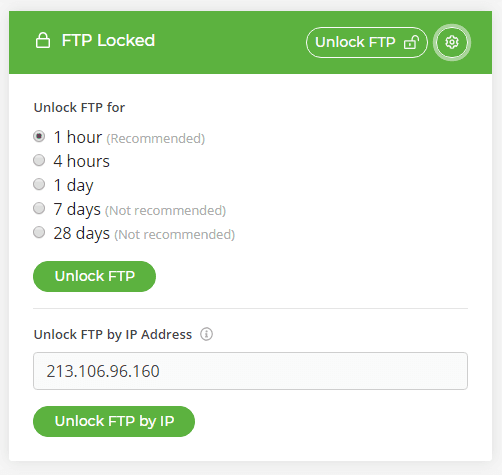
When FTP has been unlocked you'll be shown the time the unlock expires and the option to lock it again.

4. Use the correct password
Make sure you are using the correct password! You’ll need to use the password that is located within the FTP Details section of the package.
 Austin B.
Austin B.How to connect Web Hosting via FTP?
Connecting via FTP to your web hosting is quick and easy.
Ensure you have an FTP client available. We'd recommend FileZilla.
- Head to Manage Hosting
- Select Manage
- On the right-hand side of the control panel, you'll see the FTP panel. You'll need to unlock FTP by either time or IP address
- You'll see the FTP Details section that contains your FTP Server (Host), Username and Password
- Enter these details into FileZilla and select Quickconnect
You should now be connected to your web hosting via FTP.
If you're having trouble connecting via FTP, we'd recommend reviewing the guide below for common steps to diagnose what's wrong.
 Austin B.
Austin B.How to connect to your hosting package using SFTP
SFTP can be used to establish a connection to your hosting packages and make any necessary changes. The following guide will explain how to connect via SFTP.
Using SFTP to connect to Shared Hosting Packages
- First, navigate to the service overview page for the package you want to access via SFTP.
- Next, you need to unlock FTP on the hosting package, this can be done universally, or via IP.
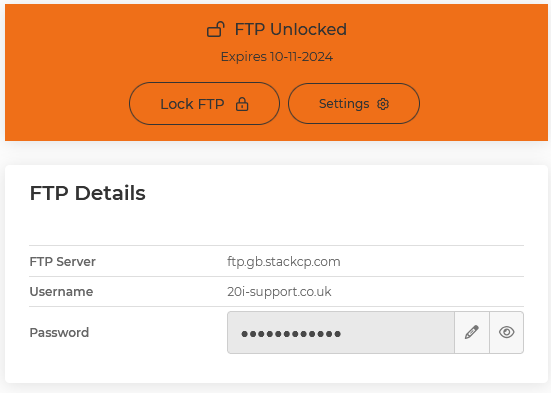
- Open your chosen FTP Client, We would recommend using FileZilla.
- Enter the FTP credentials to connect to the package, it's important to use Port 22 for SFTP.

- Click Connect, if the details entered are correct you should then be connected to the package via SFTP.
How to connect via SFTP to your Cloud Server or Managed VPS?
A different process is needed when connecting to Managed servers via SFTP. The main difference is rather than connecting via a username and password you will need to use an SSH key-pair to connect to the server. This is because to connect to a Cloud Server via SFTP you need to utilise an SSH connection.
The first step is to set up your SSH key-pair, if you haven't done this before then we have a guide on how to do this, available here.
Once you have your key-pair configured it's time to open the client you will be using to connect.
- To configure the SFTP connection within Filezilla, you need to go to File> Site Manager.
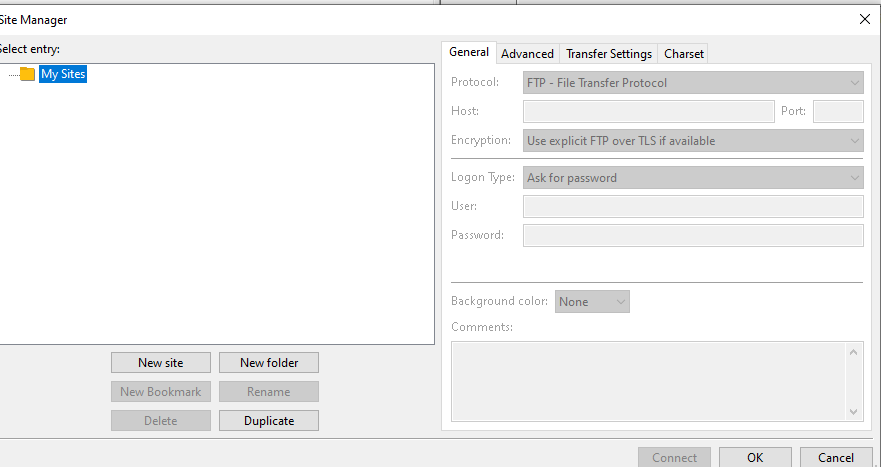
- Within the site manager, you need to click New site,
- Next change the protocol to SFTP - SSH File Transfer Protocol.
- You then need to change the Logon type to key file
- The next step is to enter the hostname, which is the SSH hostname
- Then you need to enter the port If you have a 20i Managed VPS, 20i Managed Cloud Server, or a Google Cloud server then the port you need to use is port 22. However, if you have an AWS server you need to use port 2222.
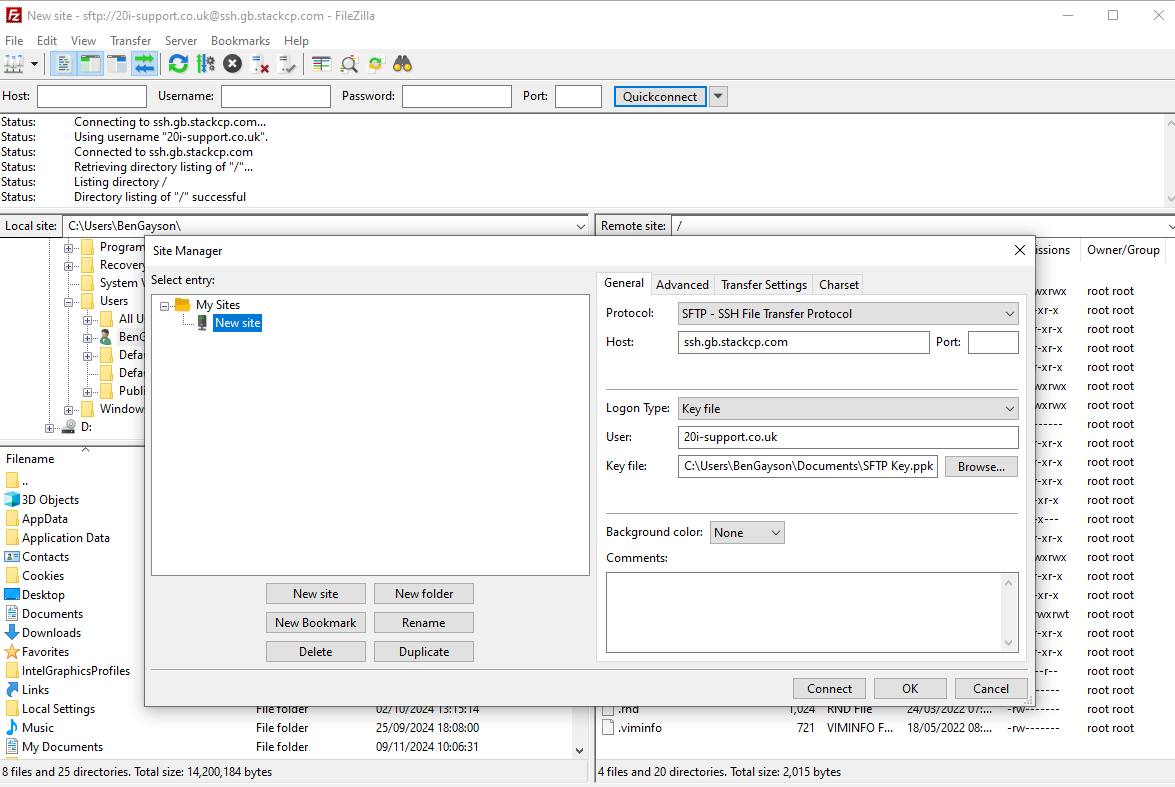
- Next, you need to click browse next to the key file and then add the key file you have created.
- Finally, click connect. If the steps have been completed successfully you should now have an open SFTP connection.

If you have any questions or need any assistance with the above feel free to contact our support team who can then assist you further.
 Ben Gayson
Ben Gayson Lloyd Cobb
Lloyd Cobb